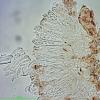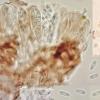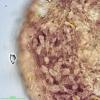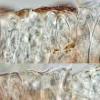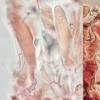
11-06-2022 13:41
 Bernard Declercq
Bernard Declercq
Hi,Once again I am in need of some papers:Checa J.

11-06-2022 10:40
 Maria Plekkenpol
Maria Plekkenpol
Hello,On wild horse dung I saw very small asco's a

11-06-2022 05:10
Masanori KutsunaHello,Xylaria liquidambar is treated as "orthograp

11-06-2022 08:59
Hola.Una aparente Nectriaceae compartiendo espacio

20-10-2014 13:27
 Yatsiuk Iryna
Yatsiuk Iryna
Hi there!Need help with this mysterious finding on

10-06-2022 17:21
Juuso ÄikäsThese Cyathiculas were growing on the same stem as

10-06-2022 20:06
 Riet van Oosten
Riet van Oosten
Hello, Found by Matthijs Molenaar on dead herbace
The disks are sessile, 80-200 µm wide, with a darker slightly raised margin. The exciple is covered with a crust covering everything and preventing a view of what is behind. A similar crust is in part also covering the hymenium (pseudoepithecium?). Asci eight-spored, 32-55 × 5.9-7.3 µm, the bases are so agglutinated that I dont't know about croziers, negative in Lugol with and without pretreatment. The spores are 7.0-8.0 × 2.6-2.9 µm, with a few small guttules at each end. The parafyses are slighly clavate, 3.0-4.2 µm at apex and unfortunately so easily dying that I can't say anything about their contents.
I can't find a Micropeziza with such small spores - or is it something else?

But I think I found some living parafyses. They have a not very refractive guttule at the apex. They are very sensitive to pressure - as soon as I touch the cover slip they are mostly gone.
The crust of my fungus is very similar to the the one on photo "Durella, II.2014-2" in the Skyttea folder.

Thank you, I suppose this is as far as it is possible to get with morphology alone.



